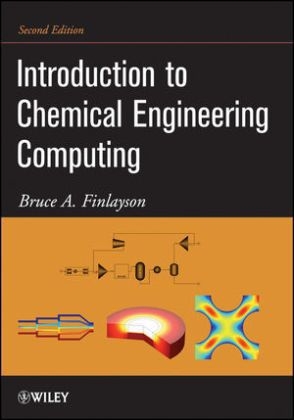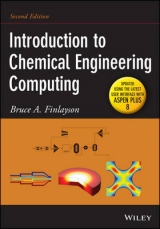
Introduction to Chemical Engineering Computing
Wiley-Blackwell (Verlag)
978-0-470-93295-7 (ISBN)
- Titel erscheint in neuer Auflage
- Artikel merken
BRUCE A. FINLAYSON, PhD, is Rehnberg Professor Emeritus of Chemical Engineering in the Department of Chemical Engineering of the University of Washington. He is also a former president of the American Institute of Chemical Engineers (AIChE). Among his many accolades and honors, Dr. Finlayson is a recipient of the AIChE's prestigious William H. Walker Award and an elected member of the National Academy of Engineering.
Preface xv 1 Introduction 1 Organization, 2 Algebraic Equations, 3 Process Simulation, 3 Differential Equations, 3 Appendices, 4 2 Equations of State 7 Equations of State--Mathematical Formulation, 8 Solving Equations of State Using Excel (Single Equation in One Unknown), 12 Solution Using "Goal Seek", 12 Solution Using "Solver", 13 Example of a Chemical Engineering Problem Solved Using "Goal Seek", 13 Solving Equations of State Using MATLAB (Single Equation in One Unknown), 15 Example of a Chemical Engineering Problem Solved Using MATLAB, 16 Another Example of a Chemical Engineering Problem Solved Using MATLAB, 18 Equations of State With Aspen Plus, 20 Example Using Aspen Plus, 20 Specific Volume of a Mixture, 21 Chapter Summary, 26 Problems, 26 Numerical Problems, 28 3 Vapor--Liquid Equilibria 29 Flash and Phase Separation, 30 Isothermal Flash--Development of Equations, 30 Example Using Excel, 32 Thermodynamic Parameters, 33 Example Using MATLAB, 34 Example Using Aspen Plus, 35 Nonideal Liquids--Test of Thermodynamic Model, 39 NIST Thermo Data Engine in Aspen Plus, 41 Chapter Summary, 44 Problems, 44 Numerical Problems, 48 4 Chemical Reaction Equilibria 49 Chemical Equilibrium Expression, 50 Example of Hydrogen for Fuel Cells, 51 Solution Using Excel, 52 Solution Using MATLAB, 53 Chemical Reaction Equilibria with Two or More Equations, 56 Multiple Equations, Few Unknowns Using MATLAB, 56 Chemical Reaction Equilibria Using Aspen Plus, 59 Chapter Summary, 59 Problems, 60 Numerical Problems, 63 5 Mass Balances with Recycle Streams 65 Mathematical Formulation, 66 Example Without Recycle, 68 Example with Recycle; Comparison of Sequential and Simultaneous Solution Methods, 70 Example of Process Simulation Using Excel for Simple Mass Balances, 72 Example of Process Simulation Using Aspen Plus for Simple Mass Balances, 73 Example of Process Simulation with Excel Including Chemical Reaction Equilibria, 74 Did the Iterations Converge?, 75 Extensions, 76 Chapter Summary, 76 Class Exercises, 76 Class Discussion (After Viewing Problem 5.10 on the Book Website), 76 Problems, 77 6 Thermodynamics and Simulation of Mass Transfer Equipment 85 Thermodynamics, 86 Guidelines for Choosing, 89 Property Method Selection Assistant, 89 Thermodynamic Models, 90 Example: Multicomponent Distillation with Shortcut Methods, 91 Multicomponent Distillation with Rigorous Plate-to-Plate Methods, 95 Example: Packed Bed Absorption, 97 Example: Gas Plant Product Separation, 100 Example: Water Gas Shift Equilibrium Reactor with Sensitivity Block and Design Specification Block, 102 Chapter Summary, 106 Class Exercise, 106 Problems (using Aspen Plus), 106 7 Process Simulation 109 Model Library, 110 Example: Ammonia Process, 110 Development of the Model, 112 Solution of the Model, 115 Examination of Results, 115 Testing the Thermodynamic Model, 118 Utility Costs, 118 Greenhouse Gas Emissions, 120 Convergence Hints, 120 Optimization, 122 Integrated Gasification Combined Cycle, 125 Cellulose to Ethanol, 126 Chapter Summary, 128 Class Exercise, 128 Problems, 128 Problems Involving Corn Stover and Ethanol, 131 8 Chemical Reactors 137 Mathematical Formulation of Reactor Problems, 138 Example: Plug Flow Reactor and Batch Reactor, 138 Example: Continuous Stirred Tank Reactor, 140 Using MATLAB to Solve Ordinary Differential Equations, 140 Simple Example, 140 Use of the "Global" Command, 142 Passing Parameters, 143 Example: Isothermal Plug Flow Reactor, 144 Example: Nonisothermal Plug Flow Reactor, 146 Using Comsol Multiphysics to Solve Ordinary Differential Equations, 148 Simple Example, 148 Example: Isothermal Plug Flow Reactor, 150 Example: Nonisothermal Plug Flow Reactor, 151 Reactor Problems with Mole Changes and Variable Density, 153 Chemical Reactors with Mass Transfer Limitations, 155 Plug Flow Chemical Reactors in Aspen Plus, 158 Continuous Stirred Tank Reactors, 161 Solution Using Excel, 162 Solution Using MATLAB, 163 CSTR with Multiple Solutions, 163 Transient Continuous Stirred Tank Reactors, 164 Chapter Summary, 168 Problems, 169 Numerical Problems (See Appendix E), 174 9 Transport Processes in One Dimension 175 Applications in Chemical Engineering--Mathematical Formulations, 176 Heat Transfer, 176 Diffusion and Reaction, 177 Fluid Flow, 178 Unsteady Heat Transfer, 180 Introduction to Comsol Multiphysics, 180 Example: Heat Transfer in a Slab, 181 Solution Using Comsol Multiphysics, 181 Solution Using MATLAB, 184 Example: Reaction and Diffusion, 185 Parametric Solution, 186 Example: Flow of a Newtonian Fluid in a Pipe, 188 Example: Flow of a Non-Newtonian Fluid in a Pipe, 190 Example: Transient Heat Transfer, 193 Solution Using Comsol Multiphysics, 193 Solution Using MATLAB, 195 Example: Linear Adsorption, 196 Example: Chromatography, 199 Pressure Swing Adsorption, 203 Chapter Summary, 204 Problems, 204 Chemical Reaction, 204 Chemical Reaction and Heat Transfer, 205 Mass Transfer, 207 Heat Transfer, 207 Electrical Fields, 207 Fluid Flow, 208 Numerical Problems (See Appendix E), 213 10 Fluid Flow in Two and Three Dimensions 215 Mathematical Foundation of Fluid Flow, 217 Navier--Stokes Equation, 217 Non-Newtonian Fluid, 218 Nondimensionalization, 219 Option One: Slow Flows, 219 Option Two: High-Speed Flows, 220 Example: Entry Flow in a Pipe, 221 Example: Entry Flow of a Non-Newtonian Fluid, 226 Example: Flow in Microfluidic Devices, 227 Example: Turbulent Flow in a Pipe, 230 Example: Start-Up Flow in a Pipe, 233 Example: Flow Through an Orifice, 235 Example: Flow in a Serpentine Mixer, 239 Microfluidics, 240 Mechanical Energy Balance for Laminar Flow, 243 Pressure Drop for Contractions and Expansions, 245 Generation of Two-Dimensional Inlet Velocity Profiles for Three-Dimensional Simulations, 246 Chapter Summary, 249 Problems, 249 11 Heat and Mass Transfer in Two and Three Dimensions 259 Convective Diffusion Equation, 260 Nondimensional Equations, 261 Example: Heat Transfer in Two Dimensions, 262 Example: Heat Conduction with a Hole, 264 Example: Convective Diffusion in Microfluidic Devices, 265 Example: Concentration-Dependent Viscosity, 268 Example: Viscous Dissipation, 269 Example: Chemical Reaction, 270 Example: Wall Reactions, 272 Example: Mixing in a Serpentine Mixer, 272 Microfluidics, 274 Characterization of Mixing, 276 Average Concentration along an Optical Path, 276 Peclet Number, 276 Example: Convection and Diffusion in a Three-Dimensional T-Sensor, 278 Chapter Summary, 280 Problems, 280 Steady, Two-Dimensional Problems, 280 Heat Transfer with Flow, 283 Reaction with Known Flow, 284 Reaction with No Flow, 285 Solve for Concentration and Flow, 286 Numerical Problems, 289 Appendix A HintsWhen Using Excel(R) 291 Introduction, 291 Calculation, 292 Plotting, 293 Import and Export, 294 Presentation, 294 Appendix B HintsWhen Using MATLAB(R) 297 General Features, 298 Screen Format, 298 Stop/Closing the Program, 299 m-files and Scripts, 299 Workspaces and Transfer of Information, 300 "Global" Command, 300 Display Tools, 301 Classes of Data, 301 Programming Options: Input/Output, Loops, Conditional Statements, Timing, and Matrices, 302 Input/Output, 302 Loops, 303 Conditional Statements, 303 Timing Information, 304 Matrices, 304 Matrix Multiplication, 304 Element by Element Calculations, 305 More Information, 306 Finding and Fixing Errors, 306 Eigenvalues of a Matrix, 307 Evaluate an Integral, 307 Spline Interpolation, 307 Interpolate Data, Evaluate the Polynomial, and Plot the Result, 308 Solve Algebraic Equations, 309 Using "fsolve", 309 Solve Algebraic Equations Using "fzero" or "fminsearch" (Both in Standard MATLAB), 309 Integrate Ordinary Differential Equations that are Initial Value Problems, 309 Differential-Algebraic Equations, 311 Checklist for Using "ode45" and Other Integration Packages, 311 Plotting, 312 Simple Plots, 312 Add Data to an Existing Plot, 312 Dress Up Your Plot, 312 Multiple Plots, 313 3D Plots, 313 More Complicated Plots, 314 Use Greek Letters and Symbols in the Text, 314 Bold, Italics, and Subscripts, 314 Other Applications, 315 Plotting Results from Integration of Partial Differential Equations Using Method of Lines, 315 Import/Export Data, 315 Import/Export with Comsol Multiphysics, 318 Programming Graphical User Interfaces, 318 MATLAB Help, 318 Applications of MATLAB, 319 Appendix C Hints When Using Aspen Plus(R) 321 Introduction, 321 Flowsheet, 322 Model Library, 322 Place Units on Flowsheet, 323 Connect the Units with Streams, 323 Data, 323 Setup, 324 Data Entry, 324 Specify Components, 325 Specify Properties, 325 Specify Input Streams, 326 Specify Block Parameters, 326 Run the Problem, 327 Scrutinize the Stream Table, 327 Checking Your Results, 328 Change Conditions, 328 Report, 328 Transfer the Flowsheet and Mass and Energy Balance to a Word Processing Program, 328 Prepare Your Report, 328 Save Your Results, 329 Getting Help, 329 Advanced Features, 329 Flowsheet Sections, 329 Mass Balance Only Simulations and Inclusion of Solids, 330 Transfer Between Excel and Aspen, 331 Block Summary, 331 Calculator Blocks, 331 Aspen Examples, 332 Molecule Draw, 332 Applications of Aspen Plus, 334 Appendix D HintsWhen Using Comsol Multiphysics(R) 335 Basic Comsol Multiphysics Techniques, 336 Opening Screens, 336 Equations, 337 Specify the Problem and Parameters, 337 Physics, 339 Definitions, 339 Geometry, 339 Materials, 340 Discretization, 341 Boundary Conditions, 341 Mesh, 342 Solve and Examine the Solution, 342 Solve, 342 Plot, 342 Publication Quality Figures, 343 Results, 343 Probes, 344 Data Sets, 344 Advanced Features, 345 Mesh, 345 Transfer to Excel, 346 LiveLink with MATLAB, 347 Variables, 348 Animation, 349 Studies, 349 Help with Convergence, 349 Help with Time-Dependent Problems, 350 Jump Discontinuity, 350 Help, 351 Applications of Comsol Multiphysics, 351 Appendix E Mathematical Methods 353 Algebraic Equations, 354 Successive Substitution, 354 Newton--Raphson, 354 Ordinary Differential Equations as Initial Value Problems, 356 Euler's Method, 356 Runge--Kutta Methods, 357 MATLAB and ode45 and ode15s, 357 Ordinary Differential Equations as Boundary Value Problems, 358 Finite Difference Method, 359 Finite Difference Method in Excel, 360 Finite Element Method in One Space Dimension, 361 Initial Value Methods, 363 Partial Differential Equations in time and One Space Dimension, 365 Problems with Strong Convection, 366 Partial Differential Equations in Two Space Dimensions, 367 Finite-Difference Method for Elliptic Equations in Excel, 367 Finite Element Method for Two-Dimensional Problems, 368 Summary, 370 Problems, 370 References 373 Index 379
| Zusatzinfo | Illustrations |
|---|---|
| Verlagsort | Hoboken |
| Sprache | englisch |
| Maße | 177 x 250 mm |
| Gewicht | 694 g |
| Einbandart | Paperback |
| Themenwelt | Mathematik / Informatik ► Informatik ► Theorie / Studium |
| Naturwissenschaften ► Chemie ► Technische Chemie | |
| Technik ► Maschinenbau | |
| ISBN-10 | 0-470-93295-3 / 0470932953 |
| ISBN-13 | 978-0-470-93295-7 / 9780470932957 |
| Zustand | Neuware |
| Haben Sie eine Frage zum Produkt? |
aus dem Bereich



